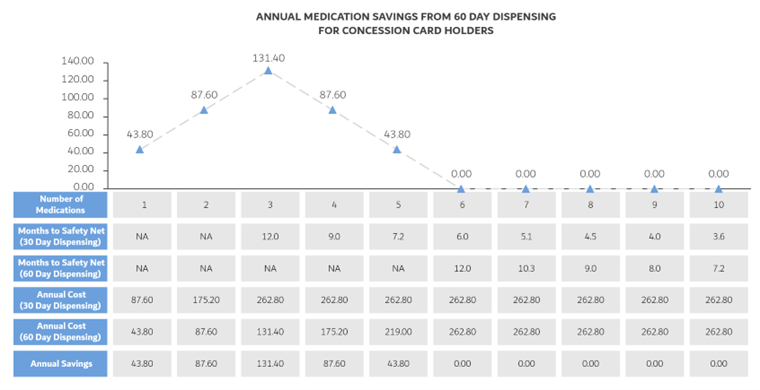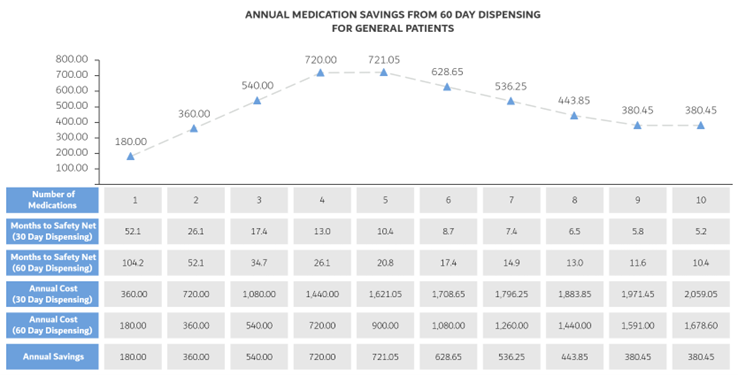Quantifying the impacts of 60 day dispensing for Australian consumers
Government budgets are fraught with winners and losers. In this article, Alex Bongers with Amplify Procurement examines the changes to medicines supply included in the Australian Government’s 2023/24 budget, identifying who in the community are the actual winners from this commitment which has provoked a mixed response from community pharmacy, general practice, and consumer groups.
Introduction
As part of Budget 2023-24, the Government announced that it will move to allow the supply of over 300 funded medicines in greater quantities. Specifically, supply of many medicines would increase from 30 to 60 days of medications for chronic conditions such as asthma, depression, diabetes, heart failure, high cholesterol, hypertension and osteoporosis.
There has been significant public debate on this change and there is no doubt doubt that there will be an impact on pharmacy profitability (particularly for smaller traditional operating model pharmacies), potential for impact on medicine availability in the short-term, increase risk of medication wastage and confusion as Australian consumers move from old to new prescriptions and the phased implementation of the program. This article won’t focus on these elements but on the estimated savings for Australian consumers.
Estimated savings for Government
Budget 2023-24 quantifies savings from this change at $1.2 billion over 5 years due to a reduction in dispensing fees paid to pharmacies for these medications.
The Government has committed to reinvesting any savings from this change into community pharmacy programs under the 7th Community Pharmacy Agreement (7CPA) as well as funding to improve access to Opioid Depending Treatment, a doubling of the Regional Pharmacy Maintenance Allowance, subsidies to support the administration of National Immunisation Program vaccines and others.
Estimated savings for patients
Savings for Australian consumers outlined in Budget 2023-24 are a multiple of the current payments and the amount of times these are paid throughout the year. The payment made for each medication is either $7.30 or $30 depending on whether the patient is a concession card holder or not.
Therefore, for a consumer without a concession card they will require 6 visits compared to 12, saving $180 per medication per year. For a consumer with a concession card, the savings are $43.80 per medication per year.
However, the savings for consumers are limited as the PBS also has Safety Net Thresholds. This threshold for concession card holders is $262.80 per year, with subsequent prescriptions being supplied at no cost. I have summarised the impact for concession card holders below.
The PBS Safety Net for general Australian consumers is $1,563.50 per year. Once this threshold is reached, prescriptions are supplied at the concession price ($7.30 per medication). I have summarised the financial impact on both concession and general consumers on 1 to 10 medications below.
Forecasted savings are further complicated by the supply of many of these medications which currently sell below $30, where estimated savings and impact to pharmacies will be negligible depending on the pricing strategy of each pharmacy. For example, fluoxetine 20mg (a common medication used in the treatment of depression) is supplied below $10 in many pharmacies. Therefore, 30 or 60 day supply is likely to cost the same amount of money over a 12 month period for a general patient.
Conclusions
As outlined in this analysis, the financial impact of this change is the largest for people without a concession card and for people on 1-5 medications. For people that are on more than 5 medications, the impact is reduced for general Australian consumers and is non-existent for concession card holders.
About the author: Alex Bongers is a Director at Amplify Procurement, a specialised procurement and supply consultancy, with a focus in the health sector. Amplify work with a range of organisations including ASX200 companies, large government organisations and some well-known Australian brands. He is contactable on abongers@amplifyprocurement.com.au



